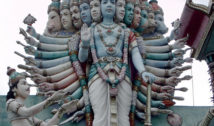
These Prayer Singing Bowls Are Not Only for Meditation, They Help Harness Solar Energy
- By Alison Lesley --
- 24 Sep 2014 --

photo: Energy Digital
Tibetan singing bowls have helped Buddhists meditate for many centuries. Now they may help significantly increase the efficiency of modern solar panels.
Engineers have been inspired by the design of Tibetan singing bowls to make solar panels that more efficiently capture sunlight and, therefore, produce more energy.
What are Buddhist Singing Bowls?
Buddhist, or Tibetan, singing bowls are a type of standing bell that are played by striking them to cause vibrations. These vibrations resonate at fundamental frequencies, usually the first harmonic. They are used worldwide for activities such as meditation, relaxation, and even music. They have been used by Buddhist monks in prayer since about 500 B.C.
Connection to Solar Power
As America and other countries expand the search for alternate power and fuel sources, solar power continues to be a primary alternative energy source. Currently, the need for more efficient and cost-effective panels are the focus of solar power research. Fortunately for scientists, Tibetan singing bowls may hold the answer. Dr. Naraj Lal has shown that when shaped like Buddhist singing bowls, his nanoscale cells perform at ten times the efficiency of regular panels.
How Do Tibetan Singing Bowls Work?
Dr. Lal’s cells operate like any other solar cells: they collect light, which is stored as energy and converted to electricity. By implementing his new design patterned off the Tibetan singing bowls and utilizing nanoscale cells, he has been able to improve efficiency by up to ten-fold. The bowls interact with light much like they do with sound, bouncing the light around for much longer than a flat panel. This allows more light to be collected, thus leading to more energy storage. Even small increases in efficiency, much less than ten-fold, translate to thousands of dollars saved over the panel’s life.
The Next Step
Although Dr. Lal has discovered a more efficient design, he has not stopped searching for techniques to increase the energy storage capabilities even more. He is experimenting with tandem devices, in which he uses another device that is capable of capturing different colors of light. Standard devices can only collect red light. By adding a device capable of seeing blue rays, the efficiency can be increased even more. These tandem devices could further improve upon solar technology, and cement its legacy as one of the best alternative power sources.



















